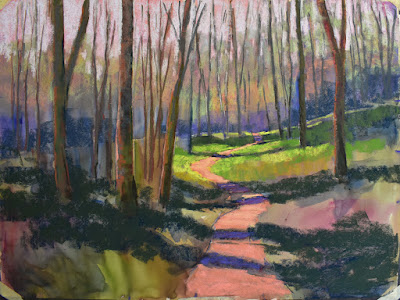 |
| Wildflowers at Raven Run Nature Sanctuary |
 |
| Raven Run Wildflowers - plein air |
 |
| Watercolor underpainting on UArt 400 grit sanded paper |
Next I add the first layers of pastel - keeping in mind it's better to start dark and go to lighter colors later. I like starting with the sky and background trees as that sets the overall color bias - in this case a slight overcast pinkish hue.
I've found that with these little wildflowers it's best to create the under color of the flowers first - the greens - and then add the blue, lavender and white flowers later.
Continue building up the layers of color. The very tiny flowers give the impression of carpeting the forest floor so my approach is to not try to paint individual flower - that would be crazy - but add a layer of color to resemble a carpet of color. The best way to view the scene, while I'm actually there, is to blur my eyes and see the color shapes, lights and shadows.
More layers of color adjusting the shadow and light shapes to create the best impression of the scene. Blue-eyed Mary's look like tiny violets with the top 2 petals white and the bottom 3 petal periwinkle blue. At a distance they have a lavender tone. Also in the forest are purple larkspur, pinkish phlox and yellow wood poppies.
 |
| Final steps for "Raven Run Wildflowers" |







